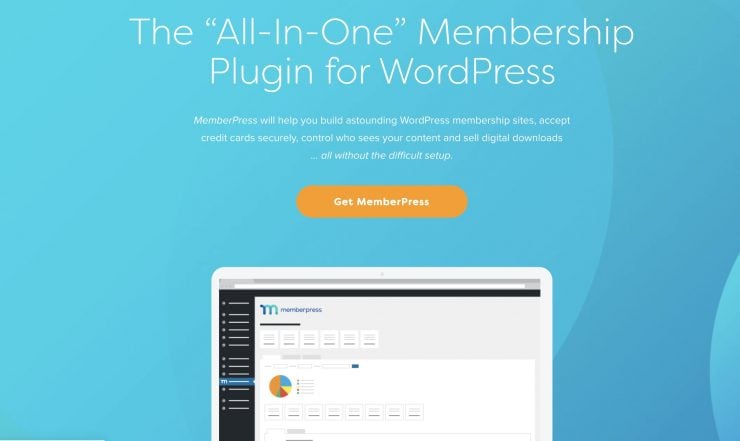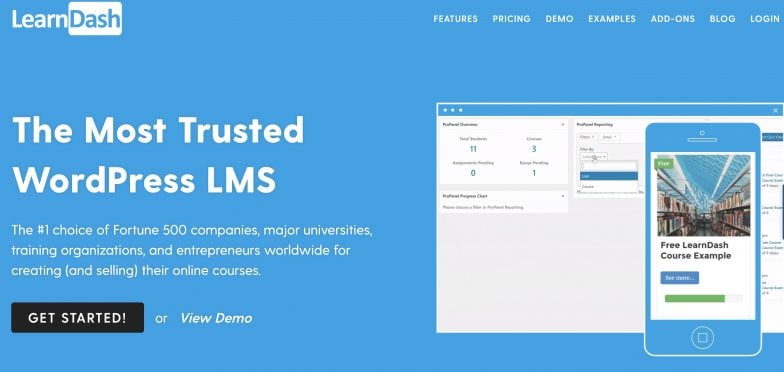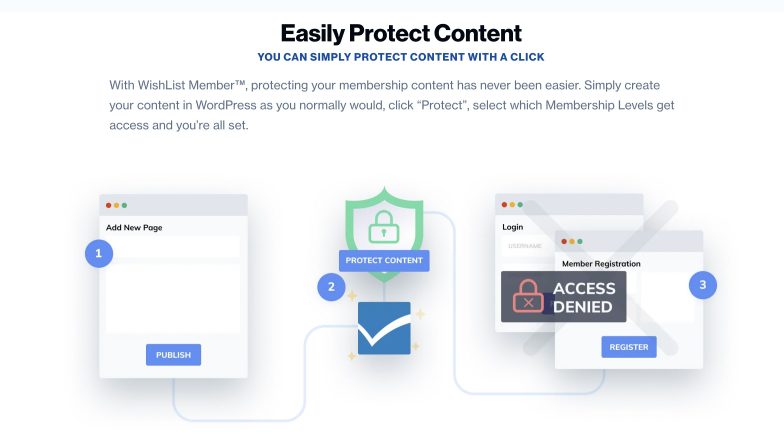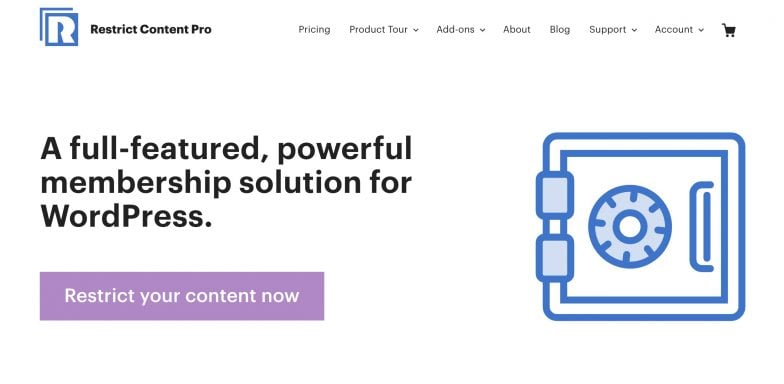How to Create a Membership Site with WordPress (2023 Update)
Matthew Turner
Updated by Tara Malone
So, you’re thinking about building a membership site with WordPress.
But is WordPress really the best option?
Why should you build your membership site with WordPress instead of a cloud-based platform like Kajabi? Both options have their pros and cons, but the main benefit of hosting your membership site with WordPress is freedom.
You get the freedom to build the membership site you desire, and to grow it and scale it over time.
As you do, you’ll reap the rewards of traffic, SEO ranking, social proof, and authority.
Simply put, if you value freedom and control, creating a WordPress membership site likely makes the most sense.
So if you want to build a membership site with WordPress, here’s what you need to do.
What Do You Need to Build a WordPress Membership Site?
Before you can do anything else, there are three elements you need to create a membership site with WordPress.
- Domain Name
- Hosting
- WordPress Membership Plugin
For starters, you’re going to need a domain name, and a self-hosted WordPress site (not one hosted via WordPress.com). You’ll also need to buy your own hosting with a service like TSO Host, Bluehost, or Siteground.
The hosting you choose is very important, because as your membership site grows, your hosting has to grow with it. A lot of this comes down to caching, as most of your membership site content is uncacheable. In the beginning, this isn’t a huge issue. But as you grow to hundreds or even thousands of members, this can cripple your site.
So make sure the hosting you choose can grow with you.
You’ll also need a WordPress membership plugin to actually build your membership site. WordPress sites aren’t designed to cater to memberships and communities, which is why you need a WordPress membership plugin to navigate this. The good news is that there are many to choose from.
We’ll overview some of the best towards the end of this guide.
But there are other steps you must follow first. Let’s begin.
How to Build a Membership Site with WordPress

So you’ve weighed your options and decided to set up your membership site using WordPress.
The good news is that the process is fairly quick and simple.
By following these steps, you’ll have your WordPress membership sit up and running before you know it.
1. Set Up Your WordPress Site
Before you choose your WordPress membership plugin, it’s important your site is ready:
- Do you have a self-hosted WordPress site (i.e. not a WordPress.com site) and solid web hosting that you can upgrade in the future?
- Do you have an SSL certificate and other security plugins and services protecting your site?
- Does your site have a fast enough loading speed?
This last one is often overlooked. If your site is loading slowly now, it will only get worse as you build your membership site. This will impact what you can do, as well as what your students experience.
It’s important you lay these foundations before you do anything else. Solving any issues now is a lot easier than trying to solve them later when you’re halfway through.
2. Choose Your WordPress Membership Plugin
This may be the most important decision you make throughout this whole process. There are many WordPress membership plugins to choose from, including both free and paid options.
Most offer most of the same features. Yet they all differ, and they all bring their own pros and cons.
We’ll overview some of the best WordPress membership plugins toward the end of this guide, including:
- MemberPress
- LearnDash
- WishList Member
Choosing the right plugin for you, your business, and your students is vital. But only you can decide which plugin will best meet your needs.
3. Set Up Your Membership Site Plugin
One you choose the best WordPress membership plugin for you and your students, you need to install it onto your site. It’s often a simple process with step-by-step guides.
To see how to do this with a few popular plugins, here are a some tutorials you may find valuable.
How To Install the MemberPress Plugin
How To Install the LearnDash Plugin
Installing the WishList Member Plugin
This initial setup process often takes minutes, and once complete, you have everything you need to build the rest of your membership site. Whatever you initially set up here isn’t set in stone. You can tweak, edit, and evolve over time.
4. Enter Your Payment Method
One of the biggest benefits of building a membership site is the ability to create a recurring, predictable income stream. As such, the payment method you choose is very important.
Each WordPress membership plugin offers different access to different payment facilitators (PayFacs) such as PayPal, Stripe, and Authorize.net. As well as the gateway, they can differ in the type of payments they take.
You need to choose the right payment provider for you; the one that will help you achieve your goals. What matters most right now is that you set up your payment method before you do anything else.
Again, it’s easier to lay the foundations now rather than try to fix it later. Make sure you get paid the way you want to get paid.
You’ll often get a choice of other settings at this stage too, including the currency you use, when and how often you get payouts, and the type of confirmation emails and receipts you send. Again, all this is important to set up now before you lose yourself in the creation process.
5. Pick Your Membership Levels
One of the best features of building a membership site is that you can create different levels for different people. This not only gives you the freedom to craft more specific content but gives your students a choice.
For example, when you first create your membership site, you may only have one or two subscription levels (i.e. Gold and Silver). Your silver membership may act as an entry-level service that gives your students access to all your courses.
The Gold Membership, on the other hand, offers all this as well as access to a private community with weekly Q&A sessions, Group Calls, and Challenges. Your students can join as a Silver Member to begin with, and upgrade later if they desire more features.
Having membership levels is extremely valuable to both you and your students. It gives your students what they need and when they need it, and you an organic method to upgrade people. It’s an essential part of the business model, and what generates so much of your recurring revenue.
Yet it doesn’t end there because in the future you may add further levels, such as a Platinum Membership that provides access to interviews, new course material, live training sessions, and group coaching. There’s no end to what you can create, and it all starts here as you build your initial membership levels.
It’s important to choose a WordPress membership plugin that allows you to create new membership levels in the future. You never know what you may want to create further down the line. It’s one of the best aspects of building a membership site in the first place… it WILL evolve.
6. Restrict Access and Add Member Only Content
Once you have your different membership levels, you need to restrict access so only certain people get to see certain content and features.
Most WordPress membership plugins give you in-depth access to what you can and cannot restrict: from individual pages/posts to entire categories or folders, and from certain lessons inside an online course or the course as a whole.
It’s important to restrict access to certain people as this gives your different membership levels value. From there, you need to ensure you continue to add new ‘Member Only’ content that non-members that visit your site cannot see (or if they can, only get access to the first part of the page before it goes behind a locked gateway).
This feature alone makes a membership site extremely powerful.
7. Design Your Sales and Pricing Page
At this stage, you’re ready to design the pages your future students will see. The first one, and arguably most important, is the sales/pricing page.
This is the page your students will see when they want to sign up for one of your membership levels. It must not only communicate your membership site as a whole (key features, who it is for, how it helps) but also explain the differences between each membership level.
From here, they’ll get redirected to a purchase page where they can complete their order.
There are a few ways you can go about this:
- Use the in-built Pricing Page that comes with the WordPress plugin
- Design your own page with a WordPress builder like Divi
Which you choose often comes down to how layered your membership site is. If you’re initially offering a simple service, the in-built pricing feature that comes with most WordPress plugins will likely do.
On the other hand, if you have a lot to communicate, you may need a more detailed long-form sales page. For this, using a tool like Divi (or other options such as Elementor) is your better option. As often is the case, the right answer depends on you, your brand, your style and voice, and, of course, your students.
8. Add Your Signup and Login Forms
Once your sales and pricing pages are complete, you must create a signup/login page that your new members can access. This is often the first page your student will see after they purchase a membership, either automatically getting redirected to this page or given access to it in their introductory email.
Once again, this page is important because it allows your new member to create their login details, giving them access to your membership site. They’ll need to create a new username and password, and possibly fill in other details such as name, address, and telephone number.
You can choose which information you would like to receive. Less is more, as you don’t want to burden your new members after they’ve just signed up. Yet it’s important you gather what you need as this means you won’t have to manually add new members to your community later.
9. Customize Your Emails
Finally, you need to customize the emails your new members automatically receive when they join, register, and are due for renewal. Each WordPress membership plugin differs, but they all auto-generate certain emails for your students, including:
- Welcome email
- Purchase receipt
- Registration/login email
- Cancellation email
- Renewal notice
- Upgrade email
It’s important you go through each email and 1) customize the copy to reflect your own voice/style, 2) link to relevant information and content on your site, and 3) ensure it gives your members what they need.
You may use other email software to create an introductory email funnel to new members, but often the email feature that comes with your WordPress membership plugin will suffice.
We go through the importance of an introductory email funnel like this in a separate guide called: 5 Email Sequence Templates for Building a Loyal Audience.
10. Analyze Your Results
The final part of this process you need to consider is how you’ll track and measure your membership site’s progress. Once more, each WordPress membership plugin differs in this regard, giving you access to different metrics.
It’s important you get clear on the metrics that matter most to you.
- Traffic
- New registrations
- Total number of members
- Total number of active members
- Number of inactive members
- Total revenue
- New revenue for the month
- Pending payments
- Failed payments
There’s a lot you can track, and there are other tools you can use to complement what your WordPress plugin offers (including Google Analytics, Crazy Egg, and HubSpot).
What matters most is that you:
- Get clear on what you’ll track and measure
- Create automatic reports that your plugin sends you each month
As your membership site grows, this part of the process can become more time-consuming. Regular reports that auto-generate not only save you time but a lot of needless stress further down the line.
This brings an end to the process and the step-by-step guide to creating valuable WordPress membership sites for your students. Regardless of the plugin you use, this process remains the same.
Yet the WordPress membership plugin you choose is key, impacting everything else you do.
It’s one of the most important decisions you’ll make, so let’s dive into 5 of the best.
5 of the Best WordPress Membership Plugins for 2023
There are many WordPress membership plugins to choose from. Some are free, though many are not.
There’s no universal best solution, only the best one for you.
The following five plugins are some of the most popular and reliable. They each provide comprehensive features for a course creator to build a membership site with WordPress.
Although each one differs, you cannot go wrong with any of these.
MemberPress

MemberPress is one of the most popular WordPress membership plugins and is also one of the easiest to use. It offers a robust set of features, including:
- Powerful access rules
- Premium community forums
- Coupons and discount features
- Drip-style content
It’s an all-in-one membership plugin that allows you to transform your current website into a fully-featured membership site.
For a full review of The MemberPress plugin, check out our article: The Ultimate MemberPress Review: How to Build the Perfect Membership Site
LearnDash

LearnDash offers one of the most trusted and widely-used WordPress membership plugins in the marketplace. It’s an easy and flexible option with a large array of features perfect for any course creator.
These features include:
- A dedicated course builder
- Private and dynamic forum areas
- Sophisticated content restrictions and access
- Mass integrations with tools such as Slack, ConvertKit, and Stripe
It’s an all-in-one solution that covers both your courses and membership site. It’s the sort of platform you can use to scale and grow later, as well as building momentum today.
WishList Member

WishList Member is one of the most robust WordPress membership plugins around, allowing you to create unlimited membership levels, protect content with a single click, integrate with your email marketing service, and much more.
It has a wide range of features, including:
- Drip-fed content
- Easy to use membership site statistics
- Unlimited membership levels
- Sophisticated access and restriction features for your content
As a course creator, this is another tool that allows you to build the membership site you desire. It gives you everything you need, but more importantly, everything your members need!
For a full review of The WishList Member plugin, check out our article: WishList Member Review: Your Best Membership Site Solution?
Restrict Content Pro

From the same team that built AffiliateWP and Easy Digital Downloads, Restrict Content Pro is one of the best WordPress membership plugins currently available. It has a huge feature-set, including:
- Built-in integrations (unlike many other plugins that offer them as a paid add-on)
- Renowned customer service and support
- An intuitive customer dashboard (giving your members certain freedom to control their account)
- Easy to navigate upgrades and add-ons, for both you and your members
This is a plugin that’s ideal for the course creator who doesn’t feel comfortable around the backend of their website. It provides an easy-to-follow process with tutorials, guides, and training throughout. It’s one of the best WordPress membership plugins in the marketplace, and one worth considering.
WooCommerce Memberships

WooCommerce Memberships is different from the other plugins in this list as it’s an add-on for WooCommerce that lets you limit content so that it’s only available to registered members of your site. As such, it only works if you use WooCommerce as your site’s store.
If you do, it’s the perfect membership plugin with a variety of useful features, including:
- Invite-only members area and forum
- Sophisticated communication and messaging tools
- Drip-fed content features
- In-depth content access and restrictions
This plugin differs from the rest on this list as it’s only relevant if you already use the WooCommerce ecosystem. If you don’t, this plugin likely won’t be what you need. Whereas if you do, it is.
Ready to Build a Membership Site with WordPress?
Should you create your membership site with WordPress? Having read this guide, you should now know the answer.
Whether you build your membership site with WordPress is entirely up to you, as they are other great third-party platforms you can use. But if you already have a WordPress site, keeping everything you own under one roof makes sense.
So if you’re ready to try out a WordPress membership plugin, we encourage you to research some of the options in this guide to see if they make sense for your business.
And if you already know what membership plugin you want to use, but you’re still struggling with what exactly you want to teach, check out our free Course Builder’s Bootcamp.
Let’s Start Building Your Online Course!
In our FREE Hybrid Courses Bootcamp, we’ll walk you through how to transform your knowledge and expertise into a profitable online course… one your students will love.